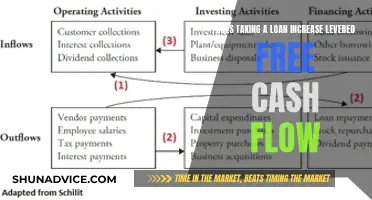
The Federal Reserve, also known as the Fed, is the central bank of the United States. While the Fed does not lend money directly to individuals, it plays a crucial role in the country's economy by influencing the money supply and interest rates. The Fed achieves this by buying securities and putting them in the reserves of commercial banks, which can then lend this money to both businesses and consumers. The Fed also lends money to banks and other depository institutions through the discount window to address temporary funding issues, such as unexpected changes in loans and deposits or extraordinary events like the financial crisis of 2008-2009.
| Characteristics | Values |
|---|---|
| Who does the Federal Reserve lend money to? | Banks and other depository institutions |
| What is the purpose of the Federal Reserve lending money? | To address temporary funding issues |
| What is the interest rate on discount window loans? | Higher than the federal funds rate |
| What is the role of the Federal Reserve in the US economy? | To keep the economy on a solid course |
| Does the Federal Reserve lend money to individuals? | No |
What You'll Learn

The Federal Reserve does not lend to individuals
The Federal Reserve, or the Fed, is the central bank of the United States. It is responsible for managing the country's money supply and controlling the supply of US dollars. While the Fed does lend money, it does not lend to individuals.
The Fed's role as a lender is primarily as a "lender of last resort" to banks and other depository institutions. This lending facility is known as the "discount window". The Fed lends to banks to address temporary funding issues they may face, such as unexpected changes in loans and deposits or extraordinary events like the financial crisis of 2008-2009 or the COVID-19 crisis. The Fed lends at a higher rate than the market to encourage banks to first seek funding from market sources and to ensure that its lending is a last resort.
The Fed does not provide bank accounts for individuals, as retail banks do. It does not hold individual checking or savings accounts, nor does it lend money to individuals. Instead, the Fed serves as a bank for other banks and government agencies, allowing them to hold their reserves, take out loans, and issue government securities.
The Fed's role in the nation's economy is often described as a credit market funnel, where it funnels funds to businesses to grow the economy. The Fed influences the money supply by purchasing securities and putting them in the reserves of commercial banks. These banks then lend funds to both businesses and consumers, ultimately adding more money to the economy as funds are deposited and loaned again.
FDIC's Role in Loan Origination: Oversight and Consumer Protection
You may want to see also

The Fed lends to banks and depository institutions
The Federal Reserve lends to banks and depository institutions to address temporary funding issues. These issues can range from common problems, such as funding pressures associated with unexpected changes in a bank's loans and deposits, to extraordinary events, such as the financial crisis of 2008 and 2009, or the COVID-19 crisis.
The Fed lends at a higher rate than the market to ensure that it is used as a last resort. This also encourages banks to first seek funding from market sources. The Federal Reserve does not lend money to individuals, as retail banks do.
The Federal Reserve, as the central bank of the United States, is responsible for controlling the supply of US dollars. It creates money by purchasing securities on the open market and adding the corresponding funds to the bank reserves of commercial banks. The Fed does not print money; this is handled by the Treasury Department's Bureau of Engraving and Printing.
The Federal Reserve System (FRS) provides loans through the discount window with a discount rate, the interest rate that applies when the Federal Reserve lends to banks. This rate is commonly higher than the federal funds rate commercial banks charge each other when providing immediate overnight liquidity. Banks can borrow at the discount rate from the Federal Reserve to meet reserve requirements.
The Fed offers three discount window programs to depository institutions: primary credit, secondary credit, and seasonal credit. Primary credit is available for banks in stable financial conditions, while secondary credit is for depository institutions that do not qualify for primary credit. Seasonal credit helps small depository institutions manage significant swings in their loans and deposits.
Botanic Gardens: Exploring Accessibility with Loaner Wheelchairs
You may want to see also

The Fed's discount window lending
The Federal Reserve, or the Fed, lends money to banks and other depository institutions, known as discount window lending. This lending is intended to address temporary funding issues that banks may face, ranging from typical funding pressures to extraordinary events such as the 2008 financial crisis. The Fed's discount window lending serves as a backup source of liquidity for banks, ensuring they can meet their customers' needs.
The discount window offers three types of credit: primary, secondary, and seasonal. Primary credit serves as the principal safety valve, ensuring adequate liquidity in the banking system. It is available to financially stable institutions and carries the lowest interest rate, known as the primary credit rate or the discount rate. Secondary credit is for banks facing financial difficulties and has a higher interest rate. Meanwhile, seasonal credit supports institutions with predictable intra-yearly fluctuations in deposits and loans, such as those in construction, farming, or resort businesses.
The discount window lending rates are set by each Reserve Bank's board of directors and are subject to review by the Board of Governors of the Federal Reserve System. These rates are typically higher than the federal funds rate to encourage banks to borrow from each other first and only turn to the Fed as a last resort. The loans are short-term, often overnight, and require collateral.
The discount window plays a crucial role in supporting the liquidity and stability of the banking system. It helps depository institutions manage their liquidity risks and maintain a smooth flow of credit to households and businesses. This function is especially vital during times of economic distress or unexpected events, where it provides a safety net for banks and ensures credit availability for the broader economy.
Tennessee Harp Loans: What You Need to Know
You may want to see also

The Fed's role in the economy
The Federal Reserve, or the Fed, is the central bank of the United States. It plays a crucial role in managing the country's economy by influencing the money supply and interest rates. While the Fed does not print money or lend directly to individuals, it serves as a "bank for banks", providing liquidity to financial institutions and ensuring the stability of the financial system.
One of the key tools the Fed uses to influence the economy is the federal funds rate, which is the suggested interest rate set by the Federal Open Market Committee (FOMC) based on the country's economic health. This rate affects the interest rates that banks charge each other for overnight loans of excess reserves. By lowering the federal funds rate, the Fed can encourage banks to lower the rates they charge on consumer loans and credit cards, making it cheaper for individuals and businesses to borrow money and stimulating economic activity.
Another way the Fed influences the money supply is by purchasing securities, such as Treasury bonds, on the open market and adding the corresponding funds to the reserves of commercial banks. This process, known as credit market funnel, can result in a significant increase in the money supply as banks lend these funds to consumers and businesses, creating new money in the economy.
The Fed also acts as a lender of last resort to banks and other depository institutions through its discount window programs. These programs provide temporary funding to banks facing liquidity issues, such as unexpected changes in loans and deposits or extraordinary events like the 2008 financial crisis. The discount rate, which is the interest rate charged by the Fed on these loans, is typically higher than the federal funds rate to ensure that banks only use it as a last resort.
Overall, the Fed's role in the economy is vital for maintaining financial stability and influencing economic activity. By managing the money supply, interest rates, and providing liquidity to financial institutions, the Fed helps to ensure the smooth functioning of the US economy.
Texas Interlibrary Loan System: How Does It Work?
You may want to see also

The Fed's influence on interest rates
The Federal Reserve, or the Fed, does not lend money to individuals. Instead, it serves as a bank for other banks and government agencies, allowing them to open accounts, take out loans, and issue government securities. The Fed lends money to banks at a higher rate than the market rate to ensure that banks only borrow from them as a last resort.
The Fed's primary role is to manage the country's monetary policy and control the supply of US dollars. It does not print money—this is handled by the Treasury Department. Instead, the Fed creates money by purchasing securities on the open market and adding the corresponding funds to the bank reserves of commercial banks.
The Fed's interest rate decisions have a wide-ranging influence on Americans' personal finances, affecting their job security, financing costs, and the direction of the economy. The Fed uses interest rates as its main lever to achieve its economic goals of price stability and maximum employment.
The federal funds rate is the target interest rate range set by the Federal Open Market Committee (FOMC) eight times a year, based on prevailing economic conditions. It is the rate at which commercial banks borrow and lend their excess reserves to each other overnight. The federal funds rate influences short-term interest rates for consumer loans, credit cards, mortgages, car loans, and more.
When the Fed raises the federal funds rate, it makes borrowing more expensive and slows down economic activity. This strategy is often used to curb inflation. On the other hand, when the economy is slow or in a recession, the Fed tends to lower rates to stimulate economic activity and help the economy expand. Lower interest rates can fuel demand, leading to increased spending and sometimes even causing inflation.
Tennessee's State Library: Borrowing System Explained
You may want to see also
Frequently asked questions
No, the Federal Reserve does not lend money or provide bank accounts for individuals. It serves as a bank for other banks and government agencies, allowing them to open accounts to hold their reserves, take out loans, issue government securities, and take other actions.
The Fed lends money to banks and other depository institutions. It provides loans to banks that are unable to meet funding requirements, either due to unexpected fluctuations in their loans and deposits or due to extreme events, such as the COVID-19 crisis or the 2008-2009 financial crisis.
The Fed influences the money supply in the economy by buying securities and putting them in the reserves of commercial banks. These banks can then lend funds to both businesses and consumers, increasing the amount of money in circulation. Additionally, the Fed can lower the reserve requirement for banks, allowing them to lend out more money.







